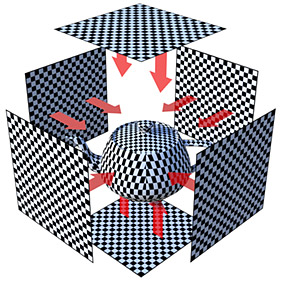Projection Type Samples
|
Projection Type Sample |
Description |
|---|---|
|
|
Solid - a Solid projection is only applicable for procedural texture layers. If you think of a procedural texture as a solid volume, this projection type renders a particular value at the intersection point of the surface, within the virtual volume of the procedural. A block of marble is a good example: the surface look as if it were carved from the procedural volume revealing the surface. |
|
|
Planar - a Planar projection is similar in concept to a movie projector, but the associated image is projected onto the surface orthographically, meaning the projection rays travel perpendicular from the virtual projection plane onto the surface. This projection type is great for flat or nearly flat surfaces. Other instances are likely to cause undesirable stretching of the texture. You can specify the axis direction, either X, Y, or Z, that you want the projection to face. |
|
|
Cylindrical - for the Cylindrical projection, the texture image is warped into a cylindrical shape and projected onto the surface. Very useful in texturing cylindrical shapes, for example, when labeling on various cans and bottles. Surfaces perpendicular to the projection produce undesirable stretching of the texture as exhibited by the lid of the teapot. You can specify the axis direction for the cylinder along the X, Y, or Z axes. |
|
|
Spherical - for the Spherical projection, the texture image is warped into a spherical shape and projected onto a surface. This is useful in texturing round objects, for example, planets and sports balls. Spherical projections are also useful in mapping 360° panoramic images for use as environment maps. Surfaces perpendicular to the projection produce undesirable stretching of the texture, as exhibited by the spout of the teapot. You can specify the axis direction for the sphere along the X, Y, or Z axes. |
|
|
Cubic - for the Cubic projection, the texture is planar-projected through a surface from all three axial directions, X, Y, and Z. A polygon receives a certain projection, based on its normal direction. This projection type is best on cube-shaped objects, and occasionally on detailed surfaces where texture seams are not of great concern. The main drawback is for textures that have a proper orientation are flipped on reverse faces. This is resolved by using the Box projection method. |
|
|
Box - similar to Cubic projection, but the Box projection type projects a texture in a planar fashion from all six directions (like an inward facing cube), eliminating reverse projections on rear facing polygons inherent to the Cubic method. This projection type is best on cube-shaped objects, and occasionally on detailed surfaces where texture seams are not of great concern. |
|
|
Front Projection - a special projection type, useful in composing 3D elements into a photograph. A Front Projected image (also called a plate) is projected out from a camera or light's position (as specified by the Projection Camera setting) often onto low resolution proxy geometry, or as a background environment. If the camera's position and view settings are set appropriately, rendered elements can be made to match with elements of the projected background. |
|
|
UV Map - UV mapping is a technique where you can precisely plot how a 2D flat image is applied onto a 3D surface by defining a 'U' horizontal and 'V' vertical position for each polygon vertex. Many primitive objects are created with automatic UV maps. Otherwise, UV maps can be easily created using any of the various UV tools available in the Texture > UV Tools menu. For surfaces with a UV map defined, this is the default projection method. |
|
|
Light Probe - Light probe images are images used to light scenes by way of image-based lighting (refer to Image Based Lighting for more information). They are typically high dynamic range imagery (HDRI) that, when applied to a scene as an Environment (and when Global Illumination is enabled), brightness information embedded in the image is used to light the scene. This produces very realistic and natural results. A popular method of of generating these HDRI images is based on taking multiple photographs of a reflective sphere. The Light Probe projection properly unwraps this chrome-sphere style of HDRI image, projecting it out as a proper spherical background. |
|
|
Implicit UV - Implicit UVs are procedurally-generated implied UVs, used to apply image maps onto fur material fibers individually. Every fiber, when set as Strips, fill the 0-1 UV space, allowing appropriate images to be mapped onto the fibers. This provides a means to make incredibly realistic grass and feathers, among other things. |










